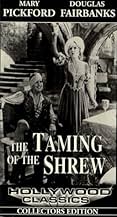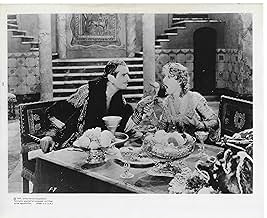अपनी भाषा में प्लॉट जोड़ेंIn sixteenth century Padua, Hortensio loves Bianca, the youngest daughter of Baptista. But Baptista will not allow the two to get married until his eldest daughter, the extremely headstrong ... सभी पढ़ेंIn sixteenth century Padua, Hortensio loves Bianca, the youngest daughter of Baptista. But Baptista will not allow the two to get married until his eldest daughter, the extremely headstrong Katherine, is betrothed. This task seems impossible because of Katherine's shrewish demean... सभी पढ़ेंIn sixteenth century Padua, Hortensio loves Bianca, the youngest daughter of Baptista. But Baptista will not allow the two to get married until his eldest daughter, the extremely headstrong Katherine, is betrothed. This task seems impossible because of Katherine's shrewish demeanor. They believe their prayers have been answered with the arrival from Verona of the lust... सभी पढ़ें
- पुरस्कार
- कुल 2 जीत
- Servant
- (बिना क्रेडिट के)
- Little Boy
- (बिना क्रेडिट के)
- Little Girl
- (बिना क्रेडिट के)
- Servant
- (बिना क्रेडिट के)
फ़ीचर्ड समीक्षाएं
The big problem is that Pickford is so small; when I got my first look at her, she looked like a little girl playing at fancy dress. Taylor stages things so she is equal in height or taller than Fairbanks when they are side by side, but when standing apart she is obviously much shorter. Maybe a match in bad manners, but she is obviously not his physical equal. For example, she is blown about by a high wind in one scene, while Fairbanks is unaffected.
Fairbanks as Petruchio is actually playing one of his swashbucklers, and Pickford as Kate is one of her many spunky waif characters. She does not inspire fear, just a "isn't that precious!" reaction given her size. Notice that when Pickford is supposedly beating up servants and smashing furniture, she does so out of view of the camera, because someone her size would not be capable of doing all of that damage.
The odd thing is that the film looks like great care went into the art direction and photography, and the supporting players are pretty good. Neither Fairbanks nor Pickford have that stiff early talkie way about them, but they are given to wild gestures as though they are still in a silent film. So it is the little things that are done well and with care, while it is the big things that sink the film. I'd give it 5/10 with four of those five going to the physical production design.
Petruchio really is quite a suitable role for Fairbanks, and his buoyant confidence works well. His portrayal seems to be pretty close to the kind of character that Shakespeare intended. The role of Katherine doesn't give Pickford a chance to use her greatest strengths. She does project good energy, and has plenty of charm when it is called for, but at times her portrayal doesn't seem to fit the original conception of the character, and the role definitely did not give Mary the chance to display her wide range of talents with more subtle material.
The story is a rather loose, jaunty adaptation of the original, and there would be little point in making detailed comparisons. As a movie, most of it works all right aside from the occasional instances of awkwardly-paced dialogue and the like that are characteristic of so many films of the early sound era. Fairbanks does help make some of these moments less noticeable with his obvious good humor. There are certainly a number of obvious ways in which it could have been better, and it's fair to point them out. Yet it still has enough of the classic story, plus enough of its own energy, to make it worth seeing as long as you know what to expect.
Of the two stars, Doug is clearly the better. Director Sam Taylor moulds the roles around the performer, and not the other way around, which was unwise but understandable. The Fairbanks image suits Petruchio better than Pickford's suits Kate. (At her best Pickford is magnificent, at her worst embarrassing. She herself called it one of her worst performances, and there is no reason to doubt her.)
For an early talkie it has remarkable fluidity, though it is only the 1966 re-edited version that is available today. (When I approached the Mary Pickford Company in 1992 to see if I could arrange a screening of the 1929 release print - which was longer and had a different score - I was politely but firmly told to go away!)
Two points of interest. This film was emphatically not the box office flop that many writers have claimed; it returned a healthy profit on its first release. And the credit line "by William Shakespeare, with additional dialogue by Sam Taylor" is pure myth. It appears not in the script, the 1966 nor in the 1929 (I have it on reliable authority) prints of the film. Where do these things get started?
क्या आपको पता है
- ट्रिवियाIn her later years, Mary Pickford stated that working on the film was the worst experience of her life, although she also acknowledged that Douglas Fairbanks's performance was one of his best.
- इसके अलावा अन्य वर्जनAfter many years out of circulation, the film was re-released in 1966 in a new cut supervised by Mary Pickford herself. New sound effects were added throughout, much of the voice dubbing was enhanced with newly available technology, and seven minutes were cut from the initial print. This re-released version is the only version now available on DVD or VHS.
- कनेक्शनFeatured in Mary Pickford: A Life on Film (1997)
टॉप पसंद
विवरण
- रिलीज़ की तारीख़
- कंट्री ऑफ़ ओरिजिन
- भाषा
- इस रूप में भी जाना जाता है
- Taming of the Shrew
- फ़िल्माने की जगहें
- उत्पादन कंपनियां
- IMDbPro पर और कंपनी क्रेडिट देखें
बॉक्स ऑफ़िस
- बजट
- $5,04,000(अनुमानित)
- चलने की अवधि1 घंटा 3 मिनट
- रंग
इस पेज में योगदान दें






























